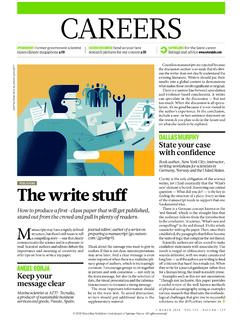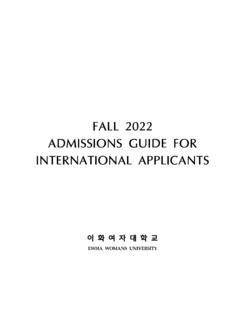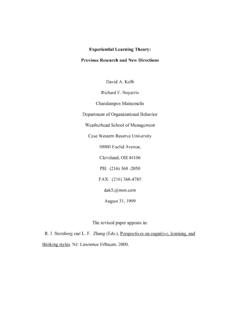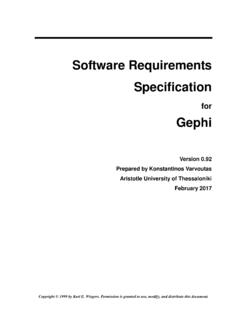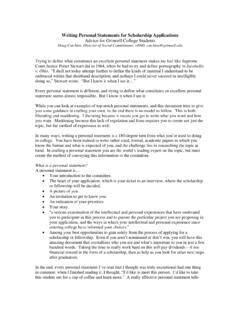Transcription of Neurons in the brain recall gut inflammation
1 Compounds, which requires first grasping the nature of the charge-density-wave phase from which it observation of time-reversal symmetry breaking is essential to our efforts to describe exotic and rare types of superconductivity. In particular, Mielke and colleagues work provides a key ingredient for developing a model to describe the vanadium antimony kagome systems. Among the crucial questions to be addressed is the relative importance of the reorganization of electrons compared with the vibration and displacement of the atoms in the lattice. Although much of the theory of charge density waves relies on these atomic displacements, the very existence of a loop-current phase implies that the electrons have a central role, which is also in line with Nie and colleagues robust model must also reconcile the presence of time-reversal-symmetry break-ing with superconductivity. This, in itself, is an exciting prospect for the broader field of topo-logical superconductivity, in which the Cooper pairs take on the topological properties of the electronic wavefunctions.
2 As well as being fascinating, topological superconductors might have future applications in quantum computing. The results of these two studies clearly bring fresh insight into symmetry breaking in kagome superconductors, and this will no doubt motivate further research into these intriguing materials. Morten H. Christensen is at the Niels Bohr Institute, University of Copenhagen, 2100 Copenhagen, Denmark. Turan Birol is in the Department of Chemical Engineering and Materials Science, University of Minnesota, Minneapolis, Minnesota 55455, USA. e-mails: 1. Mielke, C. III et al. Nature 602, 245 250 (2022).2. Ortiz, B. R. et al. Phys. Rev. Lett. 125, 247002 (2020). 3. Ortiz, B. R. et al. Phys. Rev. Mater. 5, 034801 (2021). 4. Nie, L. et al. Nature (2022).5. Moore, J. E. Nature 464, 194 198 (2010). 6. Ortiz, B. R. et al. Phys. Rev. Mater. 3, 094407 (2019). 7. Haldane, F. D. M. Phys. Rev. Lett. 61, 2015 2018 (1988). 8. Varma, C. M. Phys. Rev. B 55, 14554 14580 (1997). 9. Feng, X.
3 Zhang, Y., Jiang, K. & Hu, J. Phys. Rev. B 104, 165136 (2021).10. Jiang, Y. X. et al. Nature Mater. 20, 1353 1357 (2021). 11. Ratcliff, N., Hallett, L., Ortiz, B. R., Wilson, S. D. & Harter, J. W. Phys. Rev. Mater. 5, L111801 (2021).12. Kang, M. et al. Nature Phys. (2022).The authors declare no competing between the nervous and the immune systems have been a topic of great interest over the past few decades. Neuronal signals can affect immune functions, and immune cells can modulate the activity of Neurons in the brain and spinal cord, or in the rest of the body (known as the periphery), in health and disease1,2. Writing in Cell, Koren et demonstrate that inflammation in the abdominal cavity results in the stimulation of certain Neurons in a brain area called the insular cortex, or the insula. Artificial reacti-vation of these immune-imprinted Neurons is sufficient to generate organ-specific recall of inflammatory responses that resemble the initial inflammatory a model of inflammatory bowel disease (in which a chemical called DSS is given to mice in their drinking water to induce intes-tinal inflammation ), the authors investigated whether intestinal inflammation leads to the activation of certain brain areas.
4 To do this, they used mice genetically engineered to express a fluorescent marker molecule in active (but not inactive) Neurons when the animals were treated with the drug tamoxifen. The authors compared the fluorescent labelling in the brains of tamoxifen-treated mice given DSS with that in the brains of control mice, which were treated with tamoxifen but not with DSS. Neurons activated during episodes of bowel inflammation were identified in the insula, a region in the cerebral cortex that is involved in sensory processing and motor control (Fig. 1a).The authors injected an engineered virus into the insula of the genetically engi-neered mice so that the Neurons that were activated during bowel inflammation could be specifically reactivated by treating the animals with a small molecule called Neuroimmune interactionsNeurons in the brain recall gut inflammationDavid Brea & Henrique Veiga-FernandesThe nervous and immune systems interact in a bidirectional manner.
5 It emerges that inflammation in the body activates brain cells that, when later reactivated, can trigger a recapitulation of the inflammatory response. The discovery of a key defence response, and a collection of items from an inventor that highlights advances in photography. 100 years agoLife of Elie Metchnikoff, 1845 1916. By Olga Metchnikoff It was at Messina .. that what Metchnikoff regarded as the great event of his scientific life occurred. It is described by him in his own words as follows: One day, when the whole family had gone to a circus, I remained alone with my microscope, observing the life in the mobile cells of a transparent starfish larva, when a new thought suddenly flashed across my brain . It struck me that similar cells might serve in the defence of the organism against intruders. I felt so excited that I began striding up and down the room .. [I]f my supposition was true, a splinter introduced into the body of a starfish larva .. should soon be surrounded by mobile cells.
6 I fetched some rose-thorns and introduced them under the skin of some beautiful starfish larvae .. I was too excited to sleep that night in the expectation of the result of my experiment , and very early the next morning I ascertained that it had fully succeeded. That experiment formed the basis of the phagocyte theory .From Nature 9 February 1922150 years agoI trust you will kindly allow me space for a few lines on the subject of some rare specimens connected with the history of Photography, now in the possession of Madame Ni pce de St. Victor, whose husband it will be remembered was the first to employ glass, and a transparent medium (albumen) for the purposes of photography, thus discovering, to a great extent, the process of Photography as it exists at the present day. The first glass negative, or rather clich , Madame Ni pce possesses, as likewise prints executed in 1848. Ni pce de St. Victor was .. one of those who have worked hard to secure natural colours in the camera, some very perfect specimens photographs of coloured dolls which prove distinctly that the solution of the problem is not impossible, as many believe, are also included in the Ni pce Nature 8 February 1872 From the archiveNature | Vol 602 | 10 February 2022 | 217 2022 Springer Nature Limited.
7 All rights reserved. 2022 Springer Nature Limited. All rights (CNO). When the mice had recovered from the episode of bowel inflammation , CNO-induced reactivation of these captured insula Neurons was suffi-cient to trigger an intestinal response that was reminiscent of the initial bowel inflammation (for example, in terms of the types of immune cell observed in the gut tissue).To establish whether this recapitulated immune response was the result of activating the immune-imprinted Neurons , and not a consequence of the general activation of the insula, the authors activated this region in mice that had not had an episode of bowel inflamma-tion. In this experiment , no signs of intestinal inflammation were observed, confirming that the previously activated set of insula Neurons , rather than the insula generally, specifically encoded the immune authors report similar neuronal encoding of the immune response during inflammation of another abdominal tissue called the peritoneum (the membrane that lines the abdominal cavity), which can be induced by injection of a microbial cell-wall component called zymosan.
8 Moreover, after the zymosan-induced peritoneal inflamma-tion had resolved, artificial activation of the captured insula Neurons with CNO resulted in peritoneal inflammation that was reminiscent of the initial inflammatory reaction. The fact that the recall inflammatory responses were restricted to the peritoneum suggests that the captured insula Neurons encode anatomical information about the inflammatory response. Together, these observations indi-cate that reactivation of immune-imprinted Neurons in the brain is sufficient to induce and re capitulate inflammatory responses at specific sites in the , to shed light on the anatomical basis for communication between the insula and the intestine, the authors used a cell-labelling strategy that enables the identification of neu-ronal circuits that connect peripheral Neurons to brain areas involved in complex processing. They injected a virus encoding a fluorescent protein into the mouse intestine. This virus infected and fluorescently labelled the neu-rons innervating the intestine.
9 It propagated along these Neurons and across the synaptic connections with their partners in the circuit, and thus labelled the neural pathway from the intestine to the insula. Finally, Koren et al. tested whether inhib-iting Neurons in the insula affects the course of intestinal inflammation . To this end, they injected a different engineered virus into the insula in mice that enabled the activity of neu-rons in this region to be inhibited by treating the animals with CNO. Inhibition of insula Neurons during an episode of DSS-induced intestinal inflammation reduced some signs of inflammation , indicating that inhibition of this brain area can attenuate intestinal inflam-matory responses (Fig. 1b). Over the past decade, several studies1,2,4 8 have explored the effect of bidirectional interactions between the nervous system and the immune system on communication between organs especially between the brain and other organs, such as the intes-tine and lungs9. Koren and colleagues study builds on previous knowledge that peripheral immune responses can be encoded by certain brain areas.
10 For example, previous work has shown that responses of the innate branch of the immune system leave traces in the brain10. In mice, immune challenges in the periphery led to long-term activation of microglia (the immune cells of the brain ), and persistent microglial activation altered the progression of neurodegenerative disease in mouse and co-workers have now shown that the stimulation of immune-imprinted Neurons in the brain can induce inflammatory responses in particular peripheral organs. It is tempting to speculate that an animal s immune status can be dynamically encoded and reca-pitulated by the brain , fine-tuning the course of immune responses and associated authors study opens up fresh approaches in the field of neuroimmunol-ogy and raises many questions. Although the authors describe the neuronal pathway con-necting the insula to the intestine, it remains unclear exactly how communication between these two sites occurs. How are sensory Neurons and the autonomic nervous system (a part of the nervous system that regulates organ function) involved in this brain body communication?







